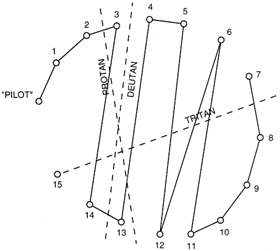Interpretation of Panel 16 Test Results
Minor Confusions
Errors between caps close to each other are common, even in persons with normal trichromatic colour vision (Figure 8).

Figure 8. Two minor confusions, #5, #6, #11 and #12 were misplaced in this case.
Crossings Across Colour Circle
Confusions between colours farther apart from each other on the colour circle (i.e., across the colour circle) also occur in normal colour vision, especially from cap #7 to #15 (Figure 4A). Less than four (4) crossings are usually accepted as normal if there is no definitive axis. Confusions occurring regularly in a certain direction across the colour space or axis (Figure 9: 3-14, 13-4, 5-12, 6-11) reveal the type of colour vision defect (Figure 9 deutan defect). Note that cap #15 was "left over;" the patient wanted to place it on the wrong side of the "pilot." In a situation like this, it is best to accept the result as it is, mix the caps and retest. More than four (4) crossings in an axis are recorded as deficient colour perception in that axis.
The border between mild and moderate colour defects is not well defined. The border between moderate and severe colour vision deficiencies is usually placed at ten (10) crossings. Different employers have different limits for confusions tolerated for specific tasks.
The three axes of colour vision defects protan, deutan and tritan are sometimes called red-blindness, green-blindness and blue-blindness, but these names are confusing. Persons with colour vision deficiencies are not colour blind, they just confuse some colours. For example, protanopes and deuteranopes, both confuse some blue and purple shades and certain brown, red and green shades. Tritanopes match violet with green.
When testing young children, we do not get the number of "crossings" across the colour circle, as stated above, because the child is not making complete colour choices in one trial. However, we do get important information about whether or not the child confuses some colours (Figure 9).

Figure 9. Crossings across the colour circle are parallel to the deutan axis in this case.
Using the Recording Form
Draw the line connecting the numbers in the order which the person has arranged the caps (Figure 4). The four diagrams on the Recording Form are used to record test results for: the training trial, binocular test, right eye and left eye. If only the binocular test is done, or the person has only one eye, the results can be recorded simply by writing down the numbers of the caps in the order that they are arranged.
If the tester wants to mark the errors, the errors can be circled. For example:
This is also the easiest way to record results in a case history. If the test is done twice, as it often is, the results can be written under each other to make it easier to see any variations. For example:
![]() (Retest on the person in Figure 4B)
(Retest on the person in Figure 4B)
In this case, there is only a mild uncertainty in the arrangement of the colours, no stable axis and less than four crossings.
When recording the results as matched pairs, write them down as in Figure 5C. The crossings can be marked on the diagram on the Recording Form as in Figure 5D.
[ Instructions I Paediatric Vision Tests I Vision Tests ]
This document was last modified on